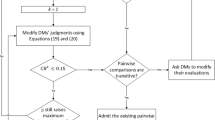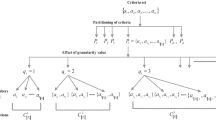Abstract
Quality function deployment (QFD) method allows reviewing of customer requirements (CRs) and design requirements (DRs) simultaneously in order to handle the correlations and relationships of CRs and DRs in calculations. It has been often combined with fuzzy numbers, because it provides to gather the judgments of experts in vagueness environment more correctly and easily. This paper suggests employing q-rung orthopair fuzzy number (q-ROFN) for improving the fuzzy QFD approach. The proposed q-ROFN based QFD method uses q-ROFN to adjust the importance degrees of CRs based the relationships between CRs and DRs with the help of the correlations and relationships of CRs and DRs. q-ROFN presents more information than numbers such as intuitionistic fuzzy number and Pythagorean fuzzy number about the correlations and relationships of CRs and DRs. Furthermore, this work proposes integrating Fine-Kinney method and QFD method to cope with limitations of Fine-Kinney method. VIKOR (VIsekriterijumska optimizacija i KOm-promisno Resenje) approach based on q-ROFN is also used to rank DRs. The proposed integrated method provides a novel decision support model for the natural gas pipeline project (NGPP) risk assessment. There is no study about the integration of Fine-Kinney, q-ROFN-based QFD, VIKOR methods. The most significant DR and the second most important DR for NGPP risk assessment are electrical sparks and coating type factor, respectively. The results of this model present a road map to the managers of NGPP for an occupational health and safety policy by ordering the failure modes.


Similar content being viewed by others
Availability of data and materials
Not applicable.
References
Akao Y (1990) Quality function deployment: integrating customer requirements into product design. Taylor & Francis
Akbaş H, Bilgen B (2017) An integrated fuzzy QFD and TOPSIS methodology for choosing the ideal gas fuel at WWTPs. Energy 125:484–497
Atanassov KT (1986) Intuitionistic fuzzy sets. Fuzzy Sets Syst 20:87–96
Can GF, Toktas P (2021) An advanced stochastic risk assessment approach proposal based on KEMIRA-M, QFD and fine-Kinney hybridization. Int J Inf Technol Decis Mak 20(1):431–468
Chen LH, Chen CN (2014) Normalisation models for prioritising design requirements for quality function deployment processes. Int J Prod Res 52(2):299–313
Cornot-Gandolphe S, Appert O, Dickel R, Chabrelie MF, Rojey A (2003) The challenges of further cost reductions for new supply options (pipeline, LNG, GTL). In: 22nd World Gas Conference, Vol. 5, pp 1–17
Du WS (2018) Minkowski-type distance measures for generalized orthopair fuzzy sets. Int J Intell Syst 33(4):802–817
Efe B (2019a) Fuzzy cognitive map based quality function deployment approach for dishwasher machine selection. Appl Soft Comput 83:105660
Efe B (2019b) Analysis of operational safety risks in shipbuilding using failure mode and effect analysis approach. Ocean Eng 187:106214
Efe B, Efe ÖF (2021) Quality function deployment based failure mode and effect analysis approach for risk evaluation. Neural Comput Appl 33:10159–10174
Efe ÖF, Efe B (2022) A decision support model based on q-rung orthopair fuzzy number for glove design application. Neural Comput Appl 34:12695–12708
Efe B, Efe ÖF, Kurt M (2018) Ergonomik ürün tasarımına bütünleşik bir yaklaşım. SAÜ Fen Bilimleri Enstitüsü Dergisi 22(2):192–202
Efe B, Yerlikaya MA, Efe ÖF (2020) Mobile phone selection based on a novel quality function deployment approach. Soft Comput 24(20):15447–15461
Efe B, Efe ÖF, Ishizaka A (2022) A model proposal to examine the effects of ships to marine pollution in terms of internal and external factors. Soft Comput 26(5):2121–2134
Gündoğdu FK, Kahraman C (2020) A novel spherical fuzzy QFD method and its application to the linear delta robot technology development. Eng Appl Artif Intell 87:103348
Kailasam S, Achanta SDM, Rao PRK, Vatambeti R, Kayam S (2021) An IoT-based agriculture maintenance using pervasive computing with machine learning technique. Int J Intell Comput Cybern 15:184–197
Kinney GF, Wiruth AD (1976) Practical risk analysis for safety management. Naval Weapons Center China Lake
Lima-Junior FR, Carpinetti LCR (2016) A multicriteria approach based on fuzzy QFD for choosing criteria for supplier selection. Comput Ind Eng 101:269–285
Liu P, Wang P (2018) Some q-rung orthopair fuzzy aggregation operators and their applications to multiple-attribute decision making. Int J Intell Syst 33(2):259–280
Narbel PA, Hansen JP (2014) Estimating the cost of future global energy supply. Renew Sustain Energy Rev 34:91–97
Onar SÇ, Büyüközkan G, Öztayşi B, Kahraman C (2016) A new hesitant fuzzy QFD approach: an application to computer workstation selection. Appl Soft Comput J 46:1–16
Opricovic S (1998) Multi-criteria optimization of civil engineering systems. Faculty of Civil Engineering, Belgrade
Rojey A, Jaffret C, Cornot-Gandolp S, Durand B (1997) Natural gas production, processing, transport. Editions Technip, Paris
Sampath Dakshina Murthy A, Karthikeyan T, Vinoth Kanna R (2022) Gait-based person fall prediction using deep learning approach. Soft Comput 26:12933–12941
Soldo B (2012) Forecasting natural gas consumption. Appl Energy 92:26–37
Wu SM, Liu HC, Wang LE (2017) Hesitant fuzzy integrated MCDM approach for quality function deployment: a case study in electric vehicle. Int J Prod Res 55(15):4436–4449
Yager RR (2017) Generalized orthopair fuzzy sets. IEEE Trans Fuzzy Syst 25(5):1222–1230
Yang Q, Chen ZS, Chan CY, Pedrycz W, Martínez L, Skibniewski MJ (2022) Large-scale group decision-making for prioritizing engineering characteristics in quality function deployment under comparative linguistic environment. Appl Soft Comput 127:109359
Yu L, Wang L, Bao Y (2018) Technical attributes ratings in fuzzy QFD by integrating interval-valued intuitionistic fuzzy sets and Choquet integral. Soft Comput 22(6):2015–2024
Zhang X, Su J, Herrera-Viedma E (2022) A decision support model for estimating participation-oriented designs of crowdsourcing platforms based on quality function deployment. Expert Syst Appl 202:117308
Funding
This study was not funded by any institution.
Author information
Authors and Affiliations
Corresponding author
Ethics declarations
Conflict of interest
Authors declare that they have no conflict of interest.
Ethical approval
This article does not contain any studies with animals performed by the authors.
Informed consent
Informed consent was obtained from all individual participants included in the study.
Additional information
Publisher's Note
Springer Nature remains neutral with regard to jurisdictional claims in published maps and institutional affiliations.
Rights and permissions
Springer Nature or its licensor (e.g. a society or other partner) holds exclusive rights to this article under a publishing agreement with the author(s) or other rightsholder(s); author self-archiving of the accepted manuscript version of this article is solely governed by the terms of such publishing agreement and applicable law.
About this article
Cite this article
Efe, B., Efe, Ö.F. Fine-Kinney method based on fuzzy logic for natural gas pipeline project risk assessment. Soft Comput 27, 16465–16482 (2023). https://doi.org/10.1007/s00500-023-09108-6
Accepted:
Published:
Issue Date:
DOI: https://doi.org/10.1007/s00500-023-09108-6




